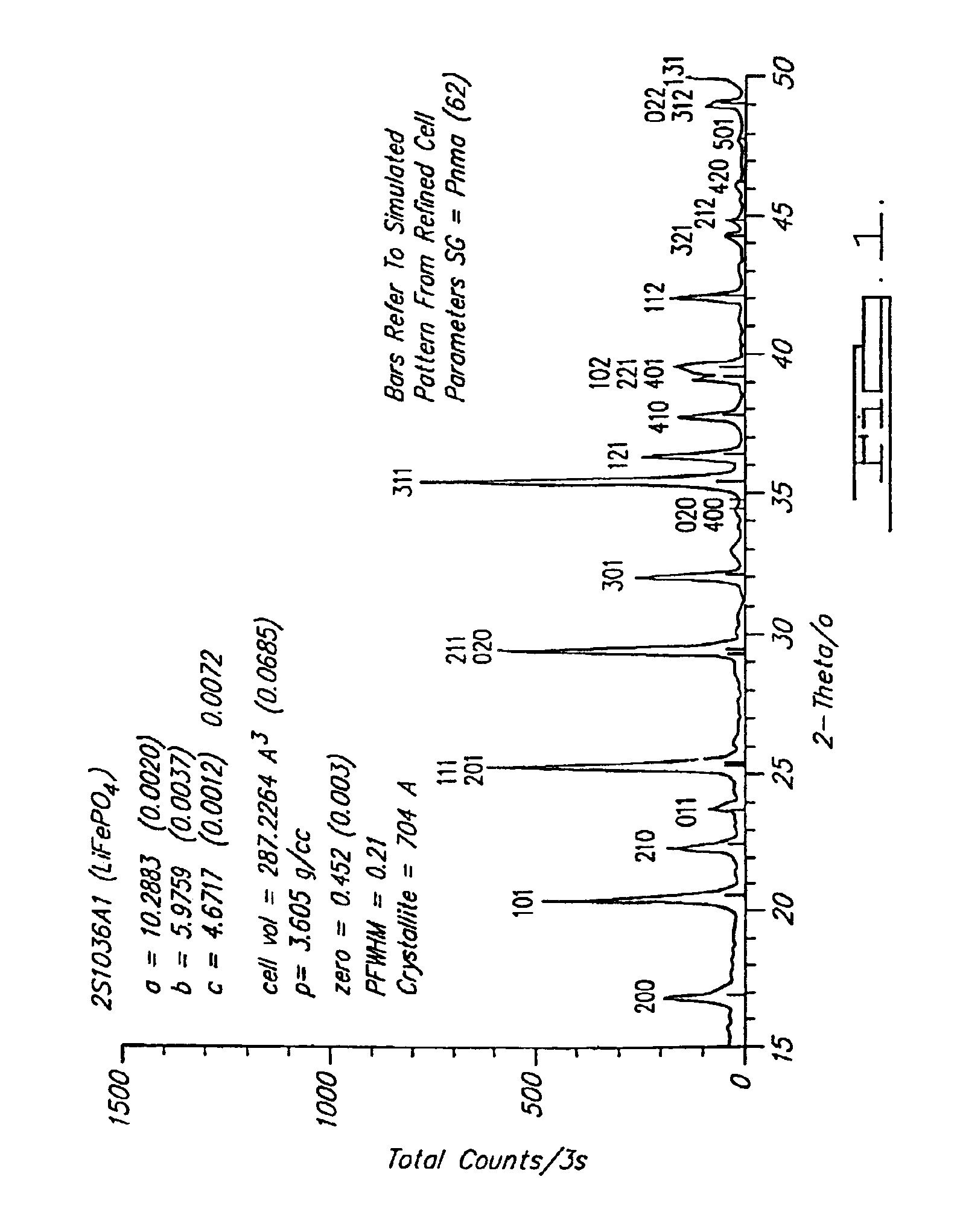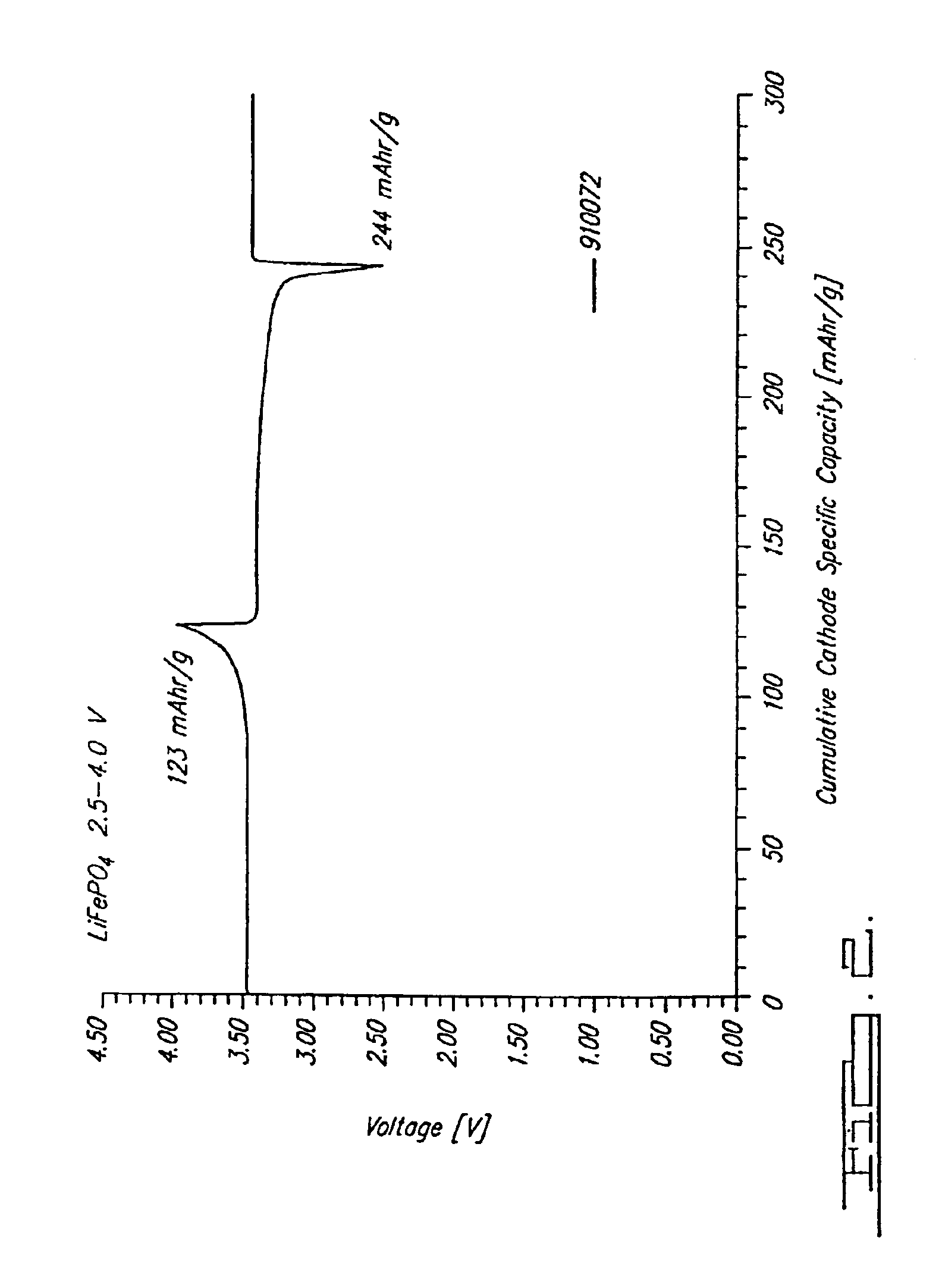Lithium-based active materials and preparation thereof
a technology of active materials and lithium-based materials, which is applied in the field can solve the problems of difficult to synthesize nickel compounds, low production efficiency, and low efficiency of lithium-based active materials, and achieves the effects of improving performance, improving capacity retention, and being readily adaptable to commercial production
- Summary
- Abstract
- Description
- Claims
- Application Information
AI Technical Summary
Benefits of technology
Problems solved by technology
Method used
Image
Examples
example i
Reaction 1(a). LiFePO4 Formed from FePO4
FePO4+0.5Li2CO3+0.5C→LiFePO4+0.5CO2+0.5CO
[0066](a) Pre-mix reactants in the following proportions using ball mill. Thus,
[0067]
1mol FePO4150.82g0.5mol Li2CO336.95g0.5mol carbon6.0g[0068](but use 100% excess carbon→12.00 g)
[0069](b) Pelletize powder mixture
[0070](c) Heat pellet to 750° C. at a rate of 2° / minute in flowing inert atmosphere (e.g. argon). Dwell for 8 hours at 750° C. under argon.
[0071](d) Cool to room temperature at 2° / minute under argon.
[0072](e) Powderize pellet.
[0073]Note that at 750° C. this is predominantly a CO reaction. This reaction is able to be conducted at a temperature in a range of about 700° C. to about 950° C. in argon as shown, and also-under other inert atmospheres such as nitrogen or vacuum.
example ii
Reaction 1(b). LiFePO4 Formed from Fe2O3
0.5 Fe2O3+0.5 Li2CO3+(NH4)2HPO4+0.5C→LiFePO4+0.5 CO2+2 NH3+3 / 2H2O+0.5 CO
[0074](a) Premix powders in the following proportions
[0075]
0.5mol Fe2O379.85g0.5mol Li2CO336.95g1mol (NH4)2HPO4132.06g0.5mol carbon6.0g[0076](use 100% excess carbon→12.00 g)
[0077](b) Pelletize powder mixture
[0078](c) Heat pellet to 750° C. at a rate of 2° / minute in flowing inert atmosphere (e.g. argon). Dwell for 8 hours at 750° C. under argon.
[0079](d) Cool to room temperature at 2° / minute under argon.
[0080](e) Powderize
example iii
Reaction 1(c). LiFePO4—from Fe3(PO4)2
[0081]Two Steps:
Part I. Carbothermal Preparation of Fe3(PO4)2
3 / 2Fe2O3+2(NH4)2HPO4+3 / 2C→Fe3(PO4)2+3 / 2CO+4 NH3+5 / 2H2O
[0082](a) Premix reactants in the following proportions
[0083]
3 / 2mol Fe2O3239.54g2mol (NH4)2HPO4264.12g3 / 2mol carbon18.00g
[0084](use 100% excess carbon→36.00 g)
[0085](b) Pelletize powder mixture
[0086](c) Heat pellet to 800° C. at a rate of 2° / minute in flowing inert atmosphere (e.g. argon). Dwell for 8 hours at 750° C. under argon.
[0087](d) Cool to room temperature at 2° C. / minute under argon.
[0088](e) Powderize pellet.
Part II. Preparation of LiFePO4 from the Fe3(PO4)2 of Part I.
Li3PO4+Fe3(PO4)2→3LiFePO4
[0089](a) Premix reactants in the following proportions
[0090]
1mol Li3PO4115.79 g1mol Fe3(PO4)2357.48 g
[0091](b) Pelletize powder mixture
[0092](c) Heat pellet to 750° C. at a rate of 2° / minute in flowing inert atmosphere (e.g. argon). Dwell for 8 hours at 750° C. under argon.
[0093](d) Cool to room temperature at 2° C. / minute under arg...
PUM
 Login to View More
Login to View More Abstract
Description
Claims
Application Information
 Login to View More
Login to View More - R&D
- Intellectual Property
- Life Sciences
- Materials
- Tech Scout
- Unparalleled Data Quality
- Higher Quality Content
- 60% Fewer Hallucinations
Browse by: Latest US Patents, China's latest patents, Technical Efficacy Thesaurus, Application Domain, Technology Topic, Popular Technical Reports.
© 2025 PatSnap. All rights reserved.Legal|Privacy policy|Modern Slavery Act Transparency Statement|Sitemap|About US| Contact US: help@patsnap.com



